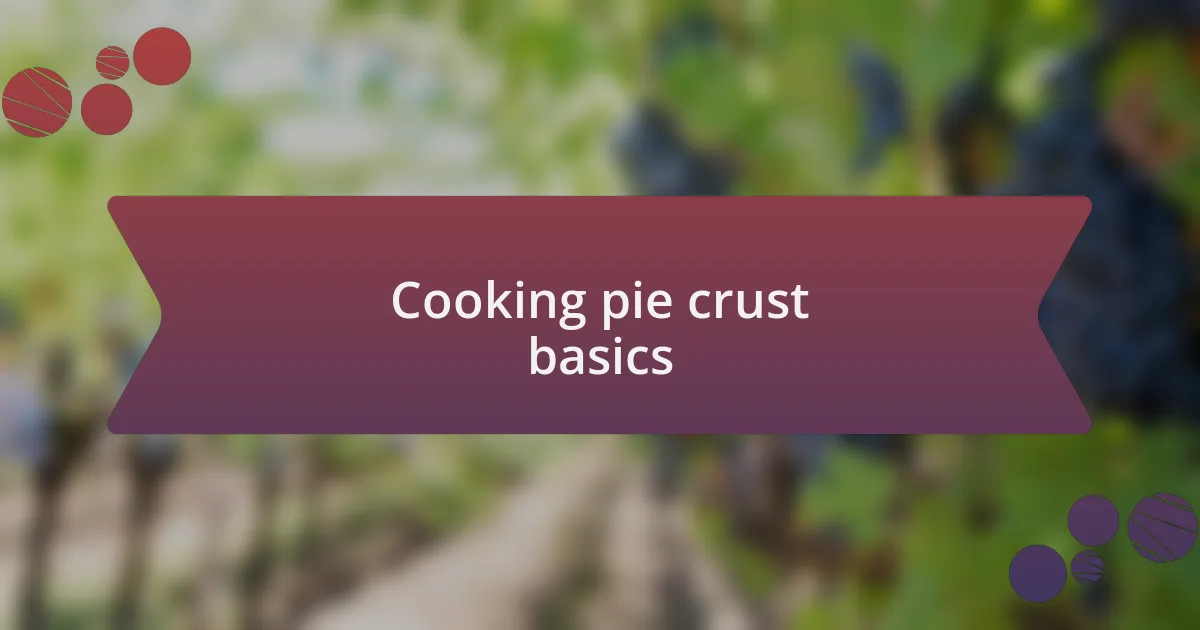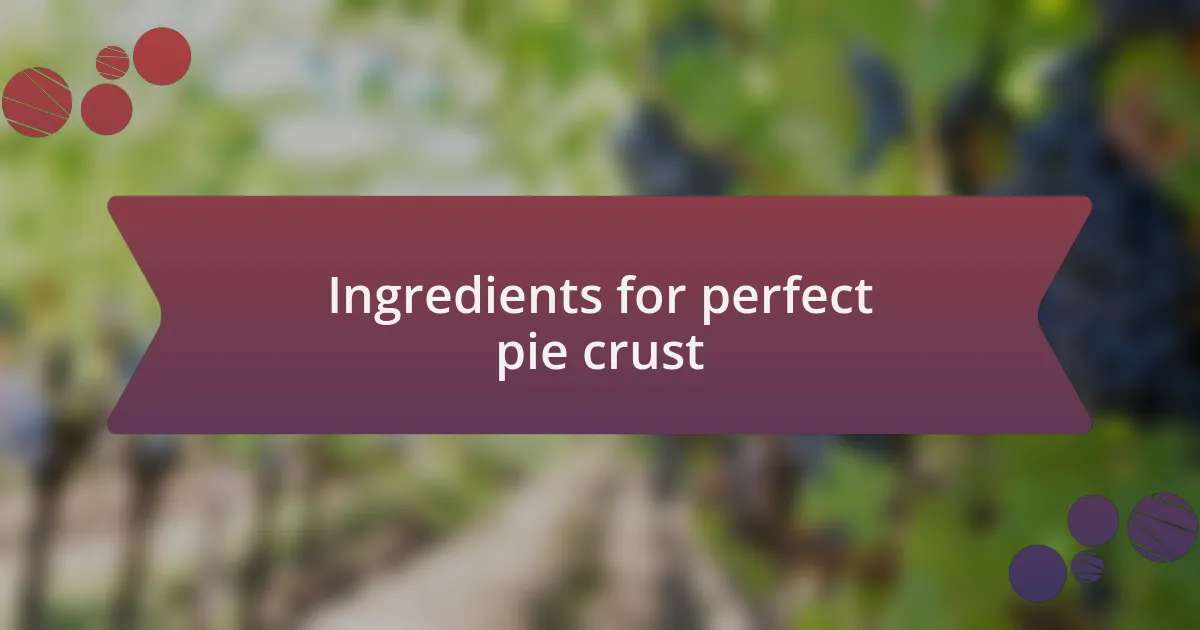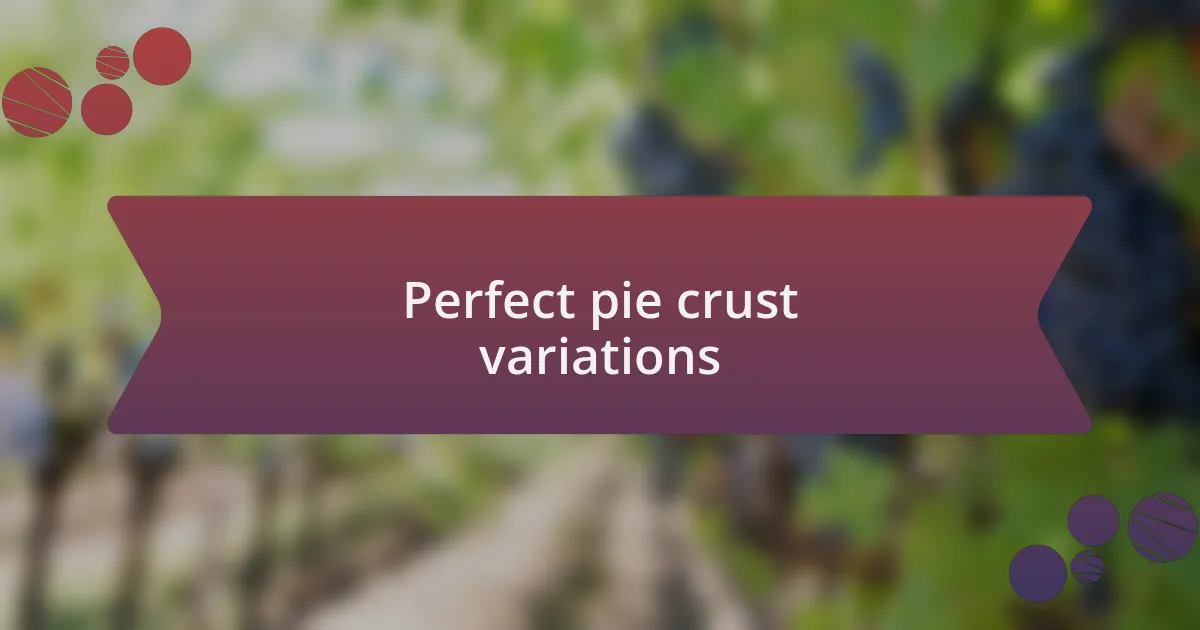Key takeaways:
- Balance of ingredients is crucial for a flaky pie crust; using the right ratios prevents toughness.
- Chill the dough for at least 30 minutes to relax gluten for a more tender texture.
- Avoid overworking the dough and let it rest to ensure optimal texture and ease of rolling.
- Experimenting with different fats and flavor additions can enhance the taste of the crust significantly.

Cooking pie crust basics
When it comes to cooking pie crust, understanding the balance of ingredients is crucial. I remember the first time I made a pie crust; I used too much flour, and it turned out tough instead of flaky. It was a lesson learned: keeping your ratios just right can make all the difference.
Chilling your dough is another essential step that I cannot stress enough. I always pop my prepared dough in the fridge for at least 30 minutes. This rest period helps the gluten relax and results in a tender crust. Have you ever noticed how a well-chilled crust rolls out so much easier? It’s like a completely different experience.
Let’s talk about the fat. I usually lean toward butter for its rich flavor, but a mix of butter and shortening can give you that perfect flakiness while enhancing the taste. The first time I tried this combination, I was amazed at how much more balanced the flavor was. Have you tried experimenting with different fats in your crust? You might just discover a new favorite!

Ingredients for perfect pie crust
When choosing the flour for my pie crust, I’ve found that all-purpose flour offers the best balance between structure and tenderness. The first time I tried using pastry flour, expecting an ultra-flaky texture, I was disappointed; it was too delicate for my liking. Have you ever experienced that, where an ingredient just doesn’t deliver what you hoped for?
Don’t underestimate the role of sugar, even in a savory pie crust. I started adding a pinch to my dough, and it transformed the flavor profile significantly. It enhances the overall taste without making the crust dessert-like. Sometimes, it’s the small adjustments that lead to the biggest surprises in cooking, don’t you agree?
Lastly, let’s not forget about salt. A few sprinkles of kosher salt have become a staple for me while making my crust. It may seem insignificant, but it really heightens the flavors and balances the richness of the fat. I can’t imagine making pie without it now; it’s like the secret handshake of pie crust perfection!

Essential tools for pie making
When it comes to pie-making, I’ve learned that the right tools can make all the difference. A reliable rolling pin is essential for achieving that perfect thickness in my crust. I remember my first attempts at rolling out dough with a flimsy tool; let’s just say my pie crusts took on some unique shapes that would make any baker cringe. Investing in a sturdy, wood or marble rolling pin has allowed me to roll with ease and precision, creating a smooth surface ready for baking.
Of all the essential tools, a good set of pastry cutters, or a bench scraper, stands out in my kitchen. I still recall the frustration of mixing butter into flour by hand—my fingers would get clammy, and the texture was never quite right. Once I started using a pastry cutter, I could achieve that desired pea-sized butter consistency without the mess. Do you remember the satisfaction of finally getting a technique just right? That’s how I feel about using the right tools.
Another game-changer has been a quality pie dish. Choosing between glass, ceramic, or metal seems trivial, but I’ve noticed that my choice affects not just texture but also the baking time. On occasion, I’ve rushed to pull out a pie, only to find the crust undercooked because of the dish’s heat distribution. Have you ever had that moment of panic? Selecting a heavy ceramic dish has made my pies come out golden and evenly baked every single time. It’s amazing how such simple decisions can lead to remarkable improvements in the final product.

My personal tips for success
When it comes to achieving the perfect pie crust, one of my favorite tips is to always ensure your ingredients are cold. I distinctly remember the first time I used room temperature butter; the dough turned into a greasy mess that barely held together. Now, I chill my flour and even the mixing bowl beforehand. It’s a small step, but cooling everything down can make a world of difference, creating that flaky texture we all crave. Have you ever felt that satisfying crunch when biting into a perfectly baked crust? That’s what I chase.
I can’t stress enough the importance of not overworking the dough. In my early baking days, I was eager to make everything perfect, so I kept kneading and rolling. This only led to tough, chewy crusts instead of the tender layers I desired. Now, I embrace the beauty of a gentle touch, mixing just until the ingredients come together. Isn’t it fascinating how being patient with the process can yield such rewarding results?
Another crucial tip I’ve learned is to let the dough rest before rolling it out. I was always so impatient, thinking that skipping this step would save time. However, I quickly discovered that resting allows the gluten to relax, making it easier to work with. I often take this opportunity to clean up my kitchen or sip a cup of tea, which turns waiting into a pleasant pause rather than a chore. Have you ever tried this? Giving your dough some time can truly elevate the final outcome.

Common mistakes to avoid
When it comes to making pie crust, a significant mistake is adding too much liquid. I recall a particularly memorable baking mishap when I poured in what I thought was just a tad more water, only to watch my dough turn into a sticky blob. Finding the right balance is crucial; a dry dough will crumble, while one that’s too wet won’t hold its shape. Have you experienced that frustrating moment when you realize your dough won’t roll out properly? It’s all about streamlining that liquid to get it just right.
Another common pitfall is skipping the blind baking step for certain pies. I remember the first time I ignored this advice—I opened the oven door to find a soggy bottom that ruined my perfectly prepared filling. Blind baking, or pre-baking the crust before adding the filling, can save you from that sad disappointment. Trust me; it’s worth the extra effort to ensure that beautiful, crisp texture.
Lastly, failing to properly crimp or seal the edges of your pie crust can lead to a culinary disaster. I used to think that a simple pinch would suffice, but I learned the hard way when a filling overflowed during baking, creating a sticky mess in my oven. A good crimp not only looks beautiful but also keeps the delicious filling where it belongs. Don’t you want that perfect slice, free of any leaks? Take the time to seal your crust properly for a successful pie every time.

Perfect pie crust variations
One exciting variation of pie crust I’ve experimented with is the addition of nuts, specifically almonds or pecans. Recently, I made a creamy lemon tart and decided to swap out part of the flour for finely ground almonds. The result was a delightful nutty flavor that enhanced the overall taste. Have you ever thought about how an unexpected ingredient could elevate a simple recipe? It’s a game-changer!
Another twist I’ve played with is a savory pie crust, perfect for quiches or vegetable pies. Instead of the usual sweet approach, I’ve incorporated herbs like thyme or rosemary into the dough. The aroma wafting through my kitchen while it baked was absolutely intoxicating! Have you tried adding fresh herbs to your crust yet? It adds a complexity that pairs beautifully with rich fillings.
Finally, let’s not forget about using different fats. While butter is my go-to for that classic flaky crust, using bacon fat in your pie crust can impart a smoky depth. I recall the surprised looks on my guests’ faces when I served a savory apple pie made with bacon fat. It was an unexpected delight that sparked lively conversations at the table. Have you considered experimenting with various fats in your crust? Each choice can lead to a unique taste profile, making each pie a new adventure.